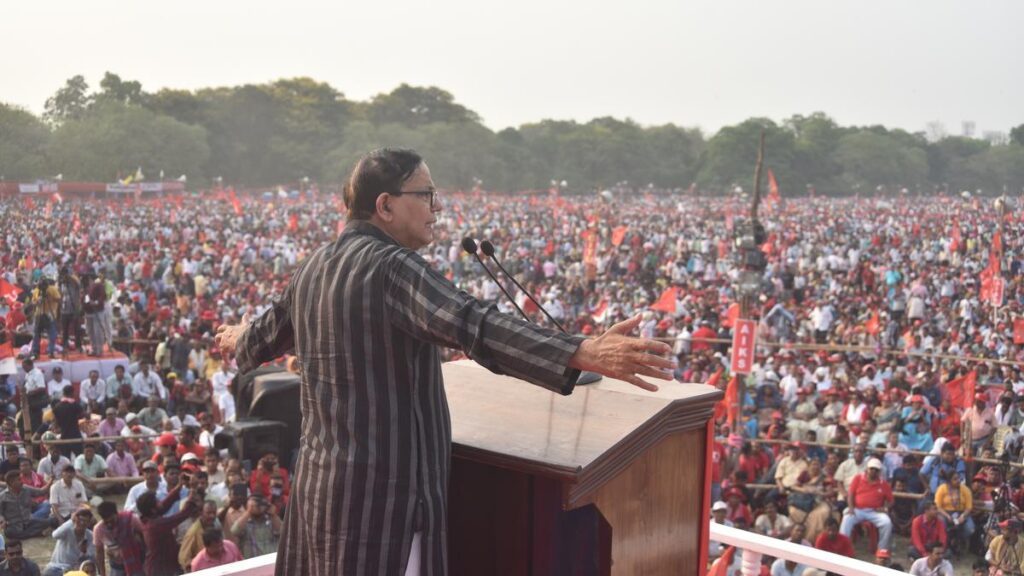RSS had worked out an inclusive strategy to arouse majoritarian communal passion in Bengal and turn the state in an ethnic violence turf, but even before the mission could be accomplished the plot got exposed. After initial incidents of violence that took place on April 11, which claimed two lives, the Hindus and Muslims of Murshidabad had come to realise that they have been made to walk through minefield and quietly retreated.
Nevertheless, one thing is certain, RSS has committed blunder. The RSS leadership could not comprehend that their plan would fizzle out ignominiously. State RSS leaders in their game of one-upmanship with the state BJP leadership failed to properly evaluate the political acumen of Mamata. Its electoral success in Haryana, Maharashtra and Delhi had made them feel sure of triumph of their strategy in Bengal too. Their plot got deactivated.
TMC chief Mamata Banerjee had come to know of the RSS design and ensured that it is disabled even before it explodes causing immense damage to the Bengali social and cultural ethics. The incidents which took place on the first two days would not have happened if the state police had taken the signals seriously and acted fast.
In her open four-page letter addressed to the people of Bengal, Mamata had taken off the lid from the plot. In the letter she alleged that saffron brigade was plotting to incite riots in the state and trying to create divisions through false propaganda. She appealed to all to maintain peace and not fall into this “dangerous trap”. Some pro BJP insiders had apprised the state administration of the plot just ahead of the Murshidabad communal flare up.
RSS had prepared the blue print of the electoral strategy during the ten-day visit of the RSS chief Mohan Bhagwat to the state in February this year. Two factors that haunted the RSS chief were; averseness of the Hindus to identify with the RSS and accept it as the articulator of their aspirations and second, consolidation of Muslim vote behind Mamata Banerjee. Bhagwat at the meet, which was participated by pracharaks and its senior leaders, especially from north Bengal, had directed them to reach out to the Bengali Hindus and also to Muslims of the region.
In the 2024 Lok Sabha elections, the Muslims of north Bengal had voted against TMC. Muslims constitute around 30 per cent of the population. RSS plan hinges on the prospect of split in the Muslim population. In that situation Mamata is sure to lose the assembly election in the region. The exigencies could be gauged from the simple fact that some RSS pracharaks and senior level cadres from other north Indian states were deputed in north Bengal for reaching out to the Hindus.
The RSS intended to use the annoyance of the Muslims towards Mamata. Bengali Muslims have been ardent supporters of Mamata. But of late they have been getting disgruntled. The TMC corruption at lower level has also affected them. This change has become perceptible after the emergence of Indian Secular Front (ISF) as the Muslim voice. ISF commands large Bengali Muslim following. Bengali Muslims believe that the Mazaar of Pir of Furfura Sharif, is the second holiest Sufi pilgrimage after Ajmer’s Dargah Sharif. ISF has been floated by two Islamic clerics, descendants of Muhammad Abu Bakr Siddique, the first Pir of Furfura. This is a religious-political party. In 2021 assembly election, ISF had an electoral understanding with Congress and CPI(M). But in that election, Muslims wary of a rising BJP, voted for TMC, though ISF got ;large Muslim votes compared to its other partners and got the lone seat from the front in the assembly.
The pitch for April riot was laid down by the Waqf Amendment Bill. Supporters of ISF and some other Muslim groups, were agitated and took it as an insult to the Muslims and infringement on their Shariat way of life. RSS which was already armed with the plan to reach out to Muslims and break their unity, used the situation. Muslims in state who are by and large with Mamata Banerjee are nonetheless split on two political lines. First, some intend to use it for their economic empowerment and gains, and second group is of those who look at TMC as an instrument to protect their existing privileges and security..
RSS plan did not have much impact on the local Hindus general. Two factors which kept it away from the Bengali Hindus are its over reliance on Hindus who had migrated to Bengal after Independence. Most of the posh areas once having substantial Hindu Bengalis have changed hands in recent years and are now the home of non-Bengali Hindus. Calcutta suburbs have also changed their economic and social character.
Though the population of the OBC and EBC has been witnessing a major surge, they are yet to help RSS and BJP to get control of the political structure of Bengal. RSS claims that Bengali Hindus have accepted their philosophy of Hindutva, but it is a wrong narrative. It is the migrant non-Bengali people who constitute the main support base. This year RSS claims to have organised 3000 Ram Navami rallies and processions in Bengal. Of course some politically committed Bengali Hindus had participated at these rallies, but the major constituents were the non-Bengali Hindus. The increase in the number of rallies also quantifies growth of their population in the state.
Undoubtedly during the past eleven years of Modi Raj, the political scenario has changed and religious-political activities have acquired prominence. But one development ought to be clarified distinctly. The upsurge does not imply that these non-Bengalis have accepted the philosophy of Hindutva. They are using the RSS and BJP for their gains and serving their class interest. Naturally increase in the number of Ram Navami processions and sprouting of Hanuman temples must not be construed as the increasing power of RSS in Bengal.
It is the BJP turncoats who have vitiated the political ambience more than the original saffron cadres. The original cadres still believe in the old Hindu testament and continue to hold Ma Durga as the supreme deity. But for turncoats, led by leaders like Subhendu Adhikari, the slogan of Jai Sri Ram is the only path for gaining material benefits and political power. These turncoats are primarily motivating force for organising Ram Navami rallies and Hanuman Jayanti celebrations. These people have been trying to assert their identity, by interweaving political messaging into religious practices.
The condition is similar with the Muslims. The politics of “us” and “them” has been at the base of intensifying acrimony. Quite interestingly the “us” and “them” element has even forced cracks within the communities. The districts of Murshidabad, Malda and Dinajpur are Muslim dominated districts, but these also have significant migrant Hindus from Bihar.
Muslim support for Trinamool grew from 51% in 2016 to 75% in 2021, while the Hindu support for BJP shot up to 57% in 2019 from 12% in 2016, and then dipped to 50% in 2021. In 2024 Lok Sabha election it witnessed a further drop of 12 per cent. This has turned RSS panicky and in its endeavour to emerge as the most potent force and come to occupy power, it is willing to go to any extent. Less than a year is left for the holding of the assembly elections in Bengal in March/ April 2026. The RSS may be working on other programmes in the remaining 11 months to influence the Hindu voters to the side of BJP in the 2026 polls. For RSS, there is no time for resting in Bengal. As Mohan Bhagwat sees it Sangh Parivar has to rule over Anga, Banga and Kalinga. Right now, excepting Banga, Anga and Kalinga are under BJP rule. So all RSS focus is now on capturing Banga in 2026 assembly polls, no matter how difficult it is with Mamata in power. (IPA Service)

 Trump’s Policy On Tariffs Indicates He May Have A Goal, But Not A Foolproof Plan
Trump’s Policy On Tariffs Indicates He May Have A Goal, But Not A Foolproof Plan 